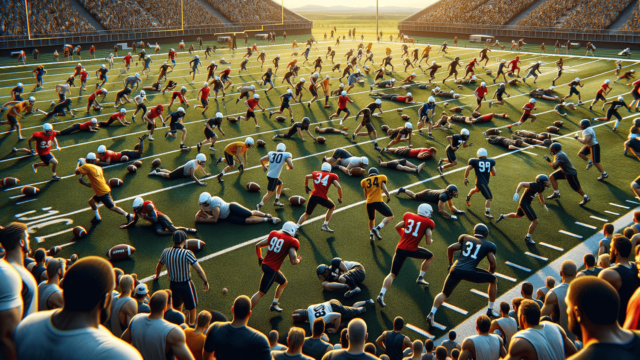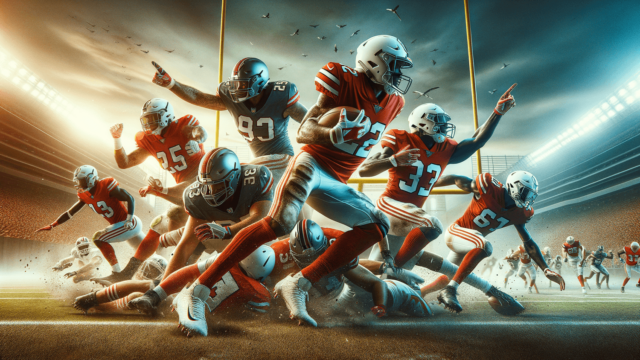
In football, ‘shells’ refer to specific formations and strategies often used during practice sessions. These shells emphasize pre-snap positioning and on-field spacing, allowing players to understand their roles, movement patterns, and responsibilities within the team’s tactical setup without engaging in full-contact physical play. Shells often include 7-on-7, 9-on-7, and 11-on-11 formations, incorporating various offensive and defensive lineups to aid both individual and team development.
Understanding Football Shells
Football shells are strategic formations and positioning utilized during practice sessions to enhance player understanding and facilitate team performance. Shells emphasize the development of various aspects, including player roles, spacing, and movement patterns, all within a safe, controlled environment devoid of full-contact gameplay.
7-on-7 Shell: Focusing on Passing Game
7-on-7 shells consist of a quarterback, running back, and five offensive players, matched up against seven defensive players. This format works on improving the passing game, as it excludes offensive and defensive linemen. The focus lies on developing quarterback-to-receiver connections, enhancing decision-making, and improving defensive players’ skills in pass coverage.
Benefits of 7-on-7 Shell
- Develops good route running and receiving skills
- Enhances the understanding of defensive and offensive coverage schemes
- Improves decision-making skills for the quarterback
- Promotes communication skills within the team
9-on-7 Shell: Perfecting the Run Game
The 9-on-7 shell focuses on the run game, incorporating offensive and defensive linemen to simulate a more realistic game scenario. In this format, the offense does not pass the ball, and the goal is to develop effective blocking schemes and run-stopping defensive strategies.
Key Components of the 9-on-7 Shell
- Develops offensive line blocking techniques
- Strengthens defensive line’s ability to stop the run
- Sharpens running back vision and decision-making
- Increases the understanding of offensive and defensive fronts
11-on-11 Shell: Simulating Game-Day Scenarios
An 11-on-11 shell practice session incorporates the complete offense and defense units, simulating near-game situations. These shells are vital for integrating the passing and running game elements while solidifying team cohesion and executing game plans. Although full-contact gameplay is excluded, this format allows both individual players and the team as a whole to perfect their assignments, develop chemistry, and merge techniques acquired in 7-on-7 and 9-on-7 shells.
11-on-11 Shell Advantages
- Allows practicing offensive and defensive game plans
- Develops communication and coordination between different units
- Fosters execution of various plays under simulated game conditions
- Promotes situational understanding and in-game adjustments
Importance of Shells in Player Development
Football shells play a vital role in player development as they provide a controlled environment to practice individual skills, understand team strategies, and improve in-game reactions. Conducting drill-based shells with limited contact helps to minimize injuries, increases learning potential, and creates a foundation for success in more competitive situations.
Incremental Progression in Shells
Incorporating different levels of complexity into shells allows the coaching staff to efficiently manage player development. By mastering simpler drills and formations first, players can gradually progress to more elaborate and nuanced schemes. This incremental approach helps build confidence, improve skill sets, and reinforce core concepts before attempting to execute them in real-game scenarios.
Shells for Special Teams
Special teams, consisting of kickoffs, punts, and field goal units, can also benefit from shells during practice sessions. Coaches can work on various aspects such as formation alignment, blocking, and tackling techniques in a safe, focused environment. Shells involving special teams help to fine-tune special teams’ coordination and execution, which can prove decisive in tightly contested games.
Special Teams Shell Components
- Improves kicking and punting accuracy
- Strengthens blocking and tackling techniques
- Fosters understanding of return and coverage strategies
- Promotes situational awareness and decision-making among special teams players
Adapting Shells for Different Skill Levels
Football shells can be adapted to suit various skill levels, ages, and development of players. For younger or less experienced players, shells may focus more on fundamental skills, building a strong foundation, and fostering basic understanding of different plays and strategies. As player knowledge and skills develop, coaches can increase shell complexity to simulate more challenging game situations, ultimately preparing athletes for higher levels of competition.
Frequently Asked Questions
This FAQ section seeks to address common concerns or inquiries related to football shells. By understanding the terminology, benefits, and practical applications surrounding shells, players, coaches, and football enthusiasts can develop a deeper appreciation for these essential practice drills.
What is the main purpose of shells in football?
The primary purpose of shells is to provide structured and controlled practice sessions, emphasizing specific aspects of the game, such as passing, running, or defense. Shells allow players to work on their roles, positioning, and movements without engaging in full-contact physical play, reducing the risk of injuries while improving their skills and understanding of the game.
How can shells help in developing team chemistry?
Shells improve team chemistry by providing a controlled setting to practice various strategies, plays, and communication skills. They promote interaction between different units on the field and help players to better understand their teammates’ roles and responsibilities, fostering enhanced coordination and team cohesion during real-game situations.
Do shells contribute to a player’s in-game decision-making skills?
Yes, shells contribute significantly to a player’s in-game decision-making skills. By simulating game scenarios in practice, players can become familiar with various situations and develop an understanding of how and when to react accordingly. Repetitive exposure to these scenarios through shells enhances their in-game instincts and quick decision-making abilities.
How can shells be adapted for different age groups or skill levels?
Shells can be adapted for different age groups and skill levels by varying the complexity of the drills and formations. For younger or less experienced players, shells may focus on fundamental skills and basic understanding of plays, while more advanced players can engage in complex tactics and challenging scenarios that prepare them for higher levels of competition.
Are special teams included in football shell practice sessions?
Yes, special teams can also benefit from shell practice sessions. Coaches can include formations and drills that focus on kicking, punts, field goal units, and other special teams aspects, helping players improve their accuracy, coordination, and situational awareness in these often crucial game situations.
Featured Posts
- No pillar pages found.





